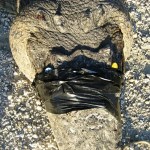reptile
An eastern painted turtle (Chrysemys picta), photographed in suburban New Jersey.
An eastern painted turtle (Chrysemys picta), photographed in suburban New Jersey.
A Cuban crocodile (Crocodylus rhombifer), photographed at the National Zoo in Washington, DC.
No one knew what happened to William Olson. At about three in the afternoon on April 13, 1966 he had been swimming with his friends from the Peace Corps in the part of the Baro river that ran through Gambela, Ethiopia when he suddenly disappeared. The last person to remember seeing him was hunter Karl Luthy. One moment Olson was standing in the river, pressing his body against the current, and the next he was gone.
Luthy could not be sure, but he was almost certain that Olson had been taken by a…
tags: art, wildlife art, stop-motion painting, Eastern Painted Turtle, Chrysemu picta, entertainment, Carel Brest van Kempen, streaming video
This is a fascinating stop-motion video of artist Carel Brest van Kempen's painting of an Eastern Painted Turtle, Chrysemu picta, a common and widespread American reptile. In my opinion, Carel Brest van Kempen is the finest wildlife artist alive today.
The original painting has been sold. Carel Brest van Kempen published a stunning book, Rigor Vitae: Life Unyielding [my review] and writes the art blog that goes by the same name, that might be of…
Recent conservation efforts in the Florida Everglades to save the American crocodile from the brink of extinction have been effective: good thing. Territorial crocodiles hanging out in Floridian's back yards, however: bad thing. The worst part? Once a crocodile is removed from its favorite haunt, it will travel tens, sometimes hundreds of miles to return, using the Earth's magnetic field as a guide. Now the Florida Fish and Wildlife Conservation Commission has turned to an interesting method of deterring the crocs' return once they have been relocated - taping magnets to the crocodiles' heads…
tags: Lepidodactylus buleli, new species discovered, Vanuatu gecko, reptiles, Ivan Ineich, Natural History Museum Paris France
French scientist, Ivan Ineich, displays a never-before-seen species of gecko at France's Natural History Museum in Paris. This gecko, formally described with the Latin name, Lepidodactylus buleli, was born in Paris from an egg that was removed from the rainforest canopy on the west coast of Espiritu Santo, one of the larger islands of the Vanuatu Archipelago, east of Australia in the South Pacific Ocean.
IMAGE: Francois Mori (AP Photo) [larger view].
According…
Don't know the background here. Not for those with weak stomachs, pretty incredible though.
Penn State University biologist Blair Hedges seems to have found his niche: identifying the world's tiniest reptiles and amphibians. Having already found world record holders for the smallest lizard and frog, Hedge's has announced the discovery of the world's smallest snake, Leptotyphlops carlae, which grows to only four inches long. Commonly known as the Barbados Thread Snake, the little guy is about .2 inches shorter than the previous record holder, which is native to Martinique.
Hedges believes this wimpy reptile may be the minimum size for a snake. The snake is blind and lays a single,…
In a sure sign that Kruger National Park in South Africa is angling to be the World Wrestling Federation of game reserves, yet another unlikely and brutal animal match-up has been caught on film. In this series of photos, a leopard ambushes a crocodile. A protracted struggle ensues but it's pretty clear who ultimately comes out on top. While crocodiles have been witnessed attacking leopards in the past, this is the first known encounter that began the other way around. Cut and pasted just for you from the pages of The Telegraph, check this out:
more below the fold
This encounter is…
StickyBot is a robot designed by researchers at Stanford Biomimetics and Dexterous Manipulation Lab as part of the Robots in Scansorial Environments project (RiSE). The robotic gecko tests their hypotheses about the "requirements for mobility on vertical surfaces using dry adhesion. The main point is that we don't need more adhesion, we need controllable adhesion."
The site boils down the "key ingredients" as follows:
* hierarchical compliance for conforming at centimeter, millimeter and micrometer scales,
* anisotropic dry adhesive materials and structures so that we can…
Researchers from Oklahoma State University have discovered the shortest living tetrapod (four limbed vertebrate) to date. The hard-livin' Labord's Chameleon spends 8-9 months incubating within the egg, only to hatch and die 4-5 months later. Published in the July issue of the Proceedings of the National Academy of Sciences, the report states: "Remarkably, this chameleon spends more of its short annual life cycle inside the egg than outside of it. Our review of tetrapod longevity (>1,700 species) finds no others with such a short life span." Most tetrapods live between 2 and 10 years.
8…
In a new discovery published in the current issue of the science affairs journal Current Biology , new research reveals that unborn baby crocodiles begin communicating to each other and their mothers moments before they are born.
He can talk. He can talk. He can talk....I CAN SINNNNNNNG!!!
It is believed that the noises, described as "umph, umph, umph," help to syncronize the hatch and signal to the mother that it's time to start preparing for her brood's emergence in the big bad world.
Scientists Amelie Vergne and Nicolas Mathevon of the French Universite Jean Monnet discovered the…
Sometimes, you find weird stuff on the internet. But sometimes you find even weirder stuff in scientific journals. To what do I refer? A paper in the Journal of Mathematical Geology back in 2000 entitled Godzilla from a Zoological Perspective, by Per Christiansen.
This was written as a critique of the "new Godzilla" movie, arguing that it is not more biologically plausible than the "old Godzilla" of 1954.
However, calculations show that his limbs and limb muscles must have been severely undersized to move his huge bulk around at even a leisurely pace, and most other biological problems with…
A new study by American and German scientists, published in the Physical Review Letters, has shed light on a classic zoological mystery: how do snakes hear?
For quite a while, researchers did not believe that snakes could hear, until tests performed in the 1970's proved otherwise. Still, those tests did not explain how the snakes managed to pick up sound. "They ain't got no ears," one prominent snake-eologist from Hope, Arkansas was noted to say. As later studies revealed, they actually do have ears, but a study released this week shows a second way for them to register noise, using their…
Fascinating BBC footage of geckos coaxing leafhoppers to feed them honeydew. The lizards tap their feet or bob their heads, and the insect dutifully tosses them a bead of delicious tree sap. This definitely qualifies as bizarre zoology.
We were sent a link to this vid by a promotions guy working for National Geographic hoping we would bring some grass roots attention to a new show they have coming up. Well we will, but only because it's great watching this moron get what he deserves.
Hopefully we will see more of Brady Barr getting bitten in the future on National Geographic's new show, Dangerous Encounters.
Ever wonder where sea creatures have been or where they're headed? Thanks to marvelous modern technology and an ambitious team of prestigious scientific organizations, now you can watch in almost real-time! Since 2002, Tagging of Pacific Pelagic (TOPPS) research project has tagged over 2,000 animals with tiny microprocessors and sophisticated remote sensing systems to track exactly where, when and how deep they're traveling through the ocean.
Movements of twelve tagged salmon sharks over the last 60 days.
The results are fantastic maps showing up-to-the-minute movements of mako sharks…
Tuatara, Sphenodon punctatus
A robotic tuatara has been put to work in Stephens Island, New Zealand, helping researchers to better understand the mating habits of its biological brethren.
Tuataras are one of the oldest reptile species on Earth, dating back 200 million years. The researchers are hoping that the data obtained by using "Robo-Ollie" will help them in relocating the reptiles when necessary and in captive breeding programs.
Robo-Ollie was built by Weta Workshops, a company that designed many robotic creatures for the Lord of the Rings movies. Though the robot is not rigged to move…

